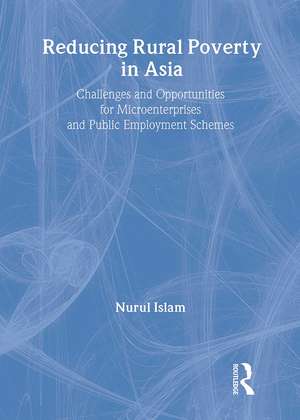Reducing Rural Poverty in Asia: Challenges and Opportunities for Microenterprises and Public Employment Schemes
Autor Nurul Islamen Limba Engleză Paperback – 28 feb 2006
The majority of the world’s poor live in Asia, and most of these live in rural areas. These areas are also infamous for the food insecurity and malnutrition associated with poverty. Making even a modest dent in rural Asian poverty has the potential to realize large gains in global human development.
Reducing Rural Poverty in Asia provides evidence-based guidelines for policymakers in developing countries, for researchers focusing on development problems, and for the international development assistance community in the continuing search for ways to effectively reduce poverty in the developing world. Detailed examinations are clearly presented on the efforts for poverty alleviation through microenterprise development and rural public employment programs that focus on public works and household/small-scale industries. Asia-based case studies of various microenterprises and rural public employment projects reveal important policy mechanisms and the effectiveness of each poverty reduction measure. Tables, figures, and relevant glossaries make unfamiliar terms and difficult information easy to understand.
Part I of Reducing Rural Poverty in Asia:
- presents a framework for the analysis of rural microenterprises with a focus on microfinance
- highlights the main findings of country-specific case studies
- suggests guidelines for an appropriate strategy for the provision of microfinance to reach the poor, alleviate poverty, and create financial stability
- analyzes the issues relating to public wage employment schemes and the principal findings of the case studies
- draws policy conclusions for the formulation of effective public employment schemes
- the SIDBI Foundation for Micro Credit in India—including the continuing problem of the exclusion of the poorest
- the Maharashtra Rural Credit Project in India and concerns about the sustainability of the financial infrastructure
- the Small Enterprises Development Project in Bangladesh and the high rate of return on capital from financed enterprises
- the successes of the Grameen Uddog, Agrani Bank Micro-Enterprise Development Unit (MEDU), and Kishoreganj Community-Based Projects in Bangladesh
- the income-stabilizing role of the Employment Guarantee Scheme in Maharashtra, India
- guidelines for the Public Works Employment policy and implementation in the Philippines
Preț: 328.28 lei
Preț vechi: 388.27 lei
-15% Nou
Puncte Express: 492
Preț estimativ în valută:
62.82€ • 68.45$ • 52.93£
62.82€ • 68.45$ • 52.93£
Comandă specială
Livrare economică 02-16 aprilie
Doresc să fiu notificat când acest titlu va fi disponibil:
Se trimite...
Preluare comenzi: 021 569.72.76
Specificații
ISBN-13: 9781560223016
ISBN-10: 1560223014
Pagini: 404
Dimensiuni: 152 x 229 x 24 mm
Greutate: 0.59 kg
Ediția:1
Editura: Taylor & Francis
Colecția Routledge
Locul publicării:Oxford, United Kingdom
ISBN-10: 1560223014
Pagini: 404
Dimensiuni: 152 x 229 x 24 mm
Greutate: 0.59 kg
Ediția:1
Editura: Taylor & Francis
Colecția Routledge
Locul publicării:Oxford, United Kingdom
Public țintă
Postgraduate, Professional, and UndergraduateCuprins
List of Acronyms,, Foreword (Joachim von Braun),, Preface,, PART I: SYNTHESIS AND MAJOR LESSONS,, Chapter 1. Rural Poverty and the Nonfarm Sector in Rural Asia,, Rural Poverty and the Nonfarm Employment Nexus,, Public Policies for the Nonfarm Sector,, Chapter 2. Rural Nonfarm Microenterprise: Salient Features and Issues,, Introduction,, Microfinance,, Financial Sustainability,, Nonfinancial Inputs,, Chapter 3. Bangladesh Case Studies: Review and Analysis,, Main Features of Microenterprise/Finance Projects,, Review of Performance,, Conclusions,, Chapter 4. Indian Case Studies: Review and Analysis,, Maharashtra Rural Credit Project,, SIDBI Foundation for Micro Credit,, Main Findings,, Conclusions,, Chapter 5. Overview of Country Experiences,, Introduction,, Patterns of Nonfarm Lending,, Institutional Mechanisms for Credit Delivery,, Noncredit Inputs: Skill, Transfer of Technology, and Market Access,, Appendix: Rural Employment Support Foundation ,, Chapter 6. Conclusions: Microfinance for Microenterprise,, Group versus Individual Lending,, Targeting the Poor,, To Reach the Poorest: An Illustration,, Financial Sustainability,, Upscaling and Financing the Missing Middle,, Not by Credit Alone,, Chapter 7. Public Employment Schemes: Case Studies in India, Bangladesh, and the Philippines,, Introduction,, The Food-for-Work Program in Bangladesh,, Jawahar Rozgar Yojana in India,, Maharashtra Employment Guarantee Scheme in India,, Public Employment Program in the Philip
Descriere
Reducing Rural Poverty in Asia provides evidence-based guidelines for policymakers in developing countries, for researchers focusing on development problems, and for the international development assistance community in the continuing search for ways to effectively reduce poverty in the developing world. Detailed examinations are clearly presented on the efforts for poverty alleviation through microenterprise development and rural public employment programs that focus on public works and household/small-scale industries. Asia-based case studies of various microenterprises and rural public employment projects reveal important policy mechanisms and the effectiveness of each poverty reduction measure. Tables, figures, and relevant glossaries make unfamiliar terms and difficult information easy to understand.
